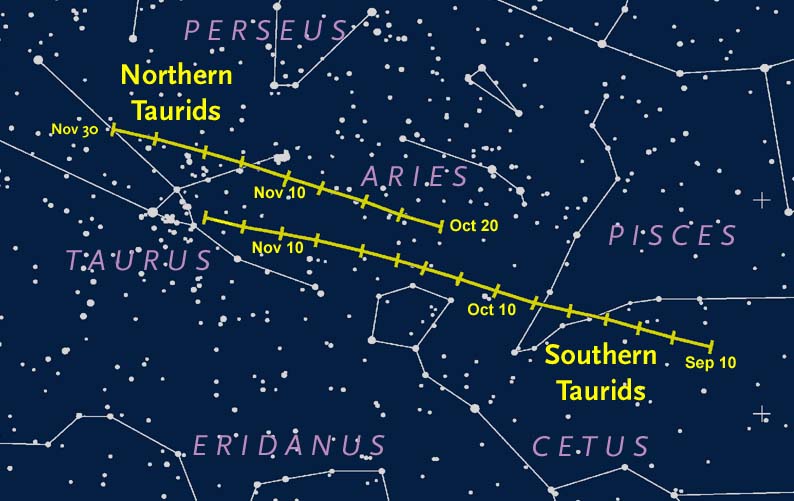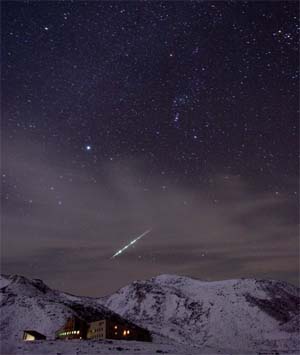If you see a really bright autumn fireball, it might be a Taurid meteor — a fragment of Comet 2P/Encke.
The Taurid meteors of October and November are unlike any other shower. They continue for many weeks, with two parallel components: the Southern Taurids, which run roughly through October and early November; and the Northern Taurids from late October through mid-November.

S&T diagram; source: IMO
The whole complex originates from periodic Comet 2P/Encke. Like the comet, the stream follows an unusually short-period orbit (about 3.3 years) near the plane of the ecliptic. Taurids catch up to Earth roughly from behind, so they are unusually slow — and the shower is as strong in the evening as in the morning hours.
Ordinarily the Taurids are a modest shower, offering roughly 20 meteors per hours under ideal dark-sky conditions. But this year the shower promises something more: a chance of occasional really brilliant fireballs, the kind that make the public call the police.
Comet Encke's debris is unusually rich in large particles. Meteor-stream modeler David Asher finds that Earth should pass through a relatively rich band of them this year. The likeliest dates run from shortly before Halloween to about November 10th.
Prospects are good for lesser meteors too. "Four of the last five northern-autumn Taurid swarm returns have each produced unusual, if variable, activity," according to the International Meteor Organization, "so there seems a good prospect that something may again happen this time."
Between October 10th and November 25th, the shower's radiant moves all the way from north of the head of Cetus to north of Aldebaran. Keep looking up, and if you see a slow meteor during October or November, check whether its path leads back toward that direction.

NASA / Hiroyuki Iida
The strongest recent Taurid return came in 2005, when many fireballs made the news around the world. The name "Halloween fireballs" for Encke's spawn seems to date from that year. On November 7, 2005, two NASA researchers apparently recorded a Taurid hitting the night side of the waxing Moon. The tiny, 7th-magnitude flash on a video recording, the NASA team calculated, would have been caused by a 12-cm (5-inch) impactor if it arrived at the Taurids' speed of 27 km per second. It probably made a crater 3 meters (10 feet) wide and 0.4 meter deep.
So will we see lots of Taurid fireballs this coming week? The editors of Sky & Telescope make this prediction: "Meteor showers have a way of fooling everyone. So have realistic expectations, enjoy the celestial show, and be prepared for a surprise."
You'll know when to look for the Taurids meteors — or any celestial event — if you have Sky & Telescope's 2016 Observing Calendar handy.
 0
0
Comments
You must be logged in to post a comment.